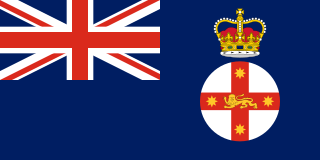
The governor of New South Wales is the representative of the monarch, King Charles III, in the state of New South Wales. In an analogous way to the governor-general of Australia at the national level, the governors of the Australian states perform constitutional and ceremonial functions at the state level. The governor is appointed by the monarch on the advice of the premier of New South Wales, and serves in office for an unfixed period of time—known as serving At His Majesty's pleasure—though five years is the general standard of office term. The current governor is retired judge Margaret Beazley, who succeeded David Hurley on 2 May 2019.

The National Flag of Canada, often simply referred to as the Canadian flag or, unofficially, as the Maple Leaf Flag or l'Unifolié, consists of a red field with a white square at its centre in the ratio of 1∶2∶1, in which is featured a stylized, red, 11-pointed maple leaf charged in the centre. It is the first flag to have been adopted by both houses of Parliament and officially proclaimed by the Canadian monarch as the country's official national flag. The flag has become the predominant and most recognizable national symbol of Canada.

The flag of Newfoundland and Labrador was introduced in 1980 and was designed by Newfoundland artist Christopher Pratt. The flag design was approved by the House of Assembly of the province of Newfoundland, Canada, on May 28, 1980. It was flown for the first time on Discovery Day, June 24, 1980. The name of the province was changed to Newfoundland and Labrador by an amendment to the constitution of Canada in December 2001 at the request of the provincial legislature.

The flag of Quebec, called the Fleurdelisé, represents the Canadian province of Quebec. It consists of a white cross on a blue background, with four white fleurs-de-lis.

The Governor-General of India was the representative of the monarch of the United Kingdom in their capacity as the Emperor/Empress of India and after Indian independence in 1947, the representative of the Monarch of India. The office was created in 1773, with the title of Governor-General of the Presidency of Fort William. The officer had direct control only over his presidency but supervised other East India Company officials in India. Complete authority over all of British territory in the Indian subcontinent was granted in 1833, and the official came to be known as the "Governor-General of India".

The provincial flag of Saskatchewan was adopted in 1969. It is blazoned per fess vert and or, in the fly a prairie lily slipped and leaved proper, in the dexter chief an escutcheon of the coat of arms of Saskatchewan fimbriated argent. The symbolism within the flag is shown just with the colours; yellow representing the grain fields in the southern portion of the province where as the green represents the northern forested areas. The western red lily in the fly of the flag is the provincial flower. In 2017, The Minister of Parks, Culture and Sports designated September 22 as Saskatchewan Flag Day.

The flag of British Columbia is based upon the shield of the provincial arms of British Columbia. At the top of the flag is a rendition of the Royal Union Flag, defaced in the centre by a crown, and with a setting sun, a view from parliament across the water at the province capitol, representing the location of the province of British Columbia at the western end of Canada.
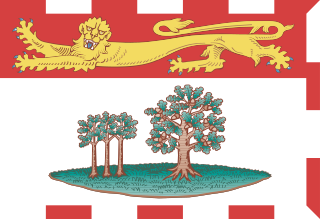
The flag of Prince Edward Island consists of a golden lion passant on a red field in the upper portion and a white field charged with three oak saplings and a large oak tree on a green island in the bottom portion. This is bordered on three edges other than the hoist by a fimbriation of alternating red and white rectangles. Adopted in 1964 in the run-up to the Canadian Centennial, it has been the flag of the province since March 24 of that year. It is a banner of arms modelled after the province's coat of arms. When flown with the flags of other Canadian provinces and the national flag, it is eighth in the order of precedence.
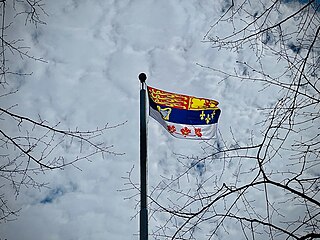
The royal standards of Canada are a set of personal flags used by members of the Canadian royal family to denote the presence of the bearer within any vehicle, building, or area within Canada or when representing Canada abroad. All are based on a banner of the coat of arms of Canada, which are the arms of the Canadian monarch.

The lieutenant governor of Quebec (; is the representative in Quebec of the monarch, who operates distinctly within the province but is also shared equally with the ten other jurisdictions of Canada, as well as the other Commonwealth realms and any subdivisions thereof, and resides predominantly in his oldest realm, the United Kingdom. The lieutenant governor of Quebec is appointed in the same manner as the other provincial viceroys in Canada and is similarly tasked with carrying out most of the monarch's constitutional and ceremonial duties. The present and 30th lieutenant governor of Quebec is Manon Jeannotte, who has served in the role since January 25, 2024.

The lieutenant governor of Alberta is the representative in Alberta of the monarch. The lieutenant governor is appointed in the same manner as the other provincial viceroys in Canada and is similarly tasked with carrying out most of the monarch's constitutional and ceremonial duties.

The lieutenant governor of British Columbia is the representative of the monarch in the province of British Columbia, Canada. The office of lieutenant governor is an office of the Crown and serves as a representative of the monarchy in the province, rather than the governor general of Canada. The office was created in 1871 when the Colony of British Columbia joined Confederation. Since then the lieutenant governor has been the representative of the monarchy in British Columbia. Previously, between 1858 and 1863 under colonial administration the title of lieutenant governor of British Columbia was given to Richard Clement Moody as commander of the Royal Engineers, Columbia Detachment. This position coexisted with the office of governor of British Columbia served by James Douglas during that time.
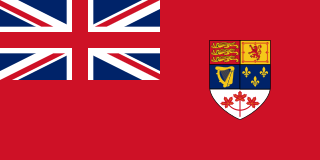
The Canadian Red Ensign served as a nautical flag and civil ensign for Canada from 1892 to 1965, and later as the de facto flag of Canada before 1965. The flag is a British Red Ensign, with the Royal Union Flag in the canton, emblazoned with the shield of the coat of arms of Canada.
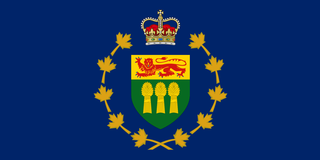
The lieutenant governor of Saskatchewan is the representative in Saskatchewan of the monarch, who operates distinctly within the province but is also shared equally with the ten other jurisdictions of Canada, as well as the other Commonwealth realms and any subdivisions thereof, and resides predominantly in his oldest realm, the United Kingdom. The lieutenant governor of Saskatchewan is appointed in the same manner as the other provincial viceroys in Canada and is similarly tasked with carrying out most of the monarch's constitutional and ceremonial duties. The current lieutenant governor is Russell Mirasty, who was appointed on July 17, 2019, following the death in office of Lieutenant Governor W. Thomas Molloy, on July 2, 2019.

The lieutenant governor of Nova Scotia is the representative in Nova Scotia of the monarch, who operates distinctly within the province but is also shared equally with the ten other jurisdictions of Canada, as well as the other Commonwealth realms and any subdivisions thereof, and resides predominantly in his oldest realm, the United Kingdom. The lieutenant governor of Nova Scotia is appointed in the same manner as the other provincial viceroys in Canada and is similarly tasked with carrying out most of the monarch's constitutional and ceremonial duties. The present, and 33rd lieutenant governor of Nova Scotia is Arthur Joseph LeBlanc, who has served in the role since 28 June 2017.

The flag of the governor general of Canada is a flag used as a symbol to mark the presence of the governor general of Canada. Such a flag has been used by governors general since just after Canadian Confederation and the design has altered over decades. The current flag was adopted in 1981.

In Canada, a lieutenant governor is the representative of the King of Canada in the government of each province. The Governor General of Canada appoints the lieutenant governors on the advice of the Prime Minister of Canada to carry out most of the monarch's constitutional and ceremonial duties for an unfixed period of time—known as serving "His Excellency’s pleasure"—though five years is the normal convention. Similar positions in Canada's three territories are termed "Commissioners" and are representatives of the federal government, not the monarch directly.

The monarchy of Canada forms the core of each Canadian provincial jurisdiction's Westminster-style parliamentary democracy, being the foundation of the executive, legislative, and judicial branches of government in each province. The monarchy has been headed since September 8, 2022 by King Charles III who as sovereign is shared equally with both the Commonwealth realms and the Canadian federal entity. He, his consort, and other members of the Canadian royal family undertake various public and private functions across the country. He is the only member of the royal family with any constitutional role.
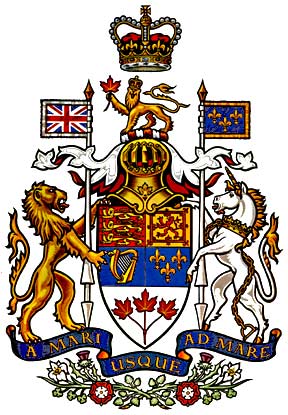
Canadian heraldry is the cultural tradition and style of coats of arms and other heraldic achievements in both modern and historic Canada. It includes national, provincial, and civic arms, noble and personal arms, ecclesiastical heraldry, heraldic displays as corporate logos, and Canadian blazonry.
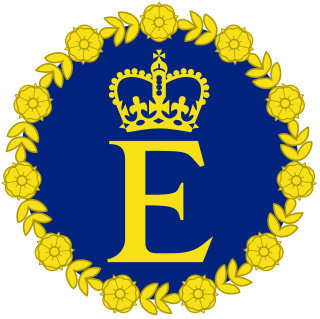
Queen Elizabeth II had a variety of flags to represent her personally and as head of state of several independent nations around the world. They were usually used on any building, ship, car, or aircraft where she was present.
















































